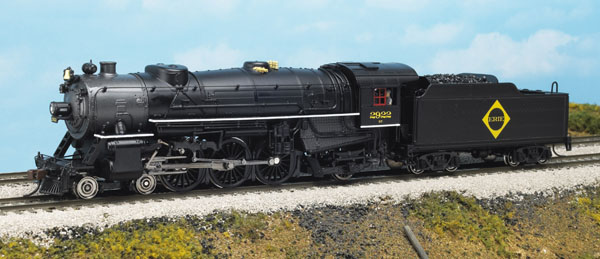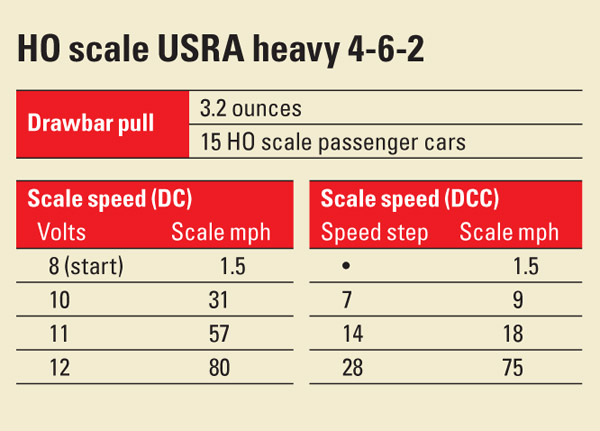The prototype. One of the 12 standard locomotive designs developed by the United States Railway Association (USRA), the heavy Pacific 4-6-2 carried more weight on its axles than its light Pacific counterpart. The heavy Pacific design also borrowed elements of other USRA locomotives. The firebox was the same as the USRA heavy Mikado 2-8-2 and the boiler was the same as the USRA light Mikado.
All 20 of the USRA heavy Pacifics built went to the Erie RR in 1919 and were classed K-5. Baldwin built nos. 2915 to 2924 and Alco built nos. 2925 to 2934. In 1923 Erie ordered 10 more heavy Pacifics with minor differences. Classed K-5a, these locomotives were numbered 2935 to 2944. Lima Locomotive Works built near copies of the USRA design with a slightly narrower boiler for the Chicago & Eastern Illinois RR. (BLI also sells its USRA Pacific model decorated for C&EI and a Baltimore & Ohio class P-7 4-6-2, which has similar proportions but not the same dimensions as the USRA design.)
The K-5 and K-5a locomotives had long careers hauling passenger trains on the Erie. They received major upgrades in the early 1930s and during a rebuilding program in 1940-41. All were retired and scrapped by 1952.
The driver diameter on the model is 73″ and the spacing between drivers is 6′-6″, which is correct for a light USRA Pacific. A heavy USRA Pacific had 79″ drivers with 7 feet between drivers.
The model depicts Erie K-5 no. 2922 as it appeared prior to 1931 before the railroad installed an Elesco feedwater heater with its distinctive tank mounted across the top of the smokebox. Most of the molded details on the primarily plastic model match prototype photos and drawings.
Although there aren’t any builder’s plates printed on the model, there’s a molded outline for a rectangular builder’s plate, which would be correct for an Alco-built locomotive. However, this road number would have been part of the Baldwin-built group, so it should have round builder’s plates.
The model has the correct USRA Cole-style trailing truck. The later K-5a locomotives had Commonwealth Delta trailing trucks.
The running boards on the model don’t match the prototype. On the prototype, the running board is in three pieces: one length over the steam chest then two steps up to a length along the drivers, and then two steps down to a length along the firebox. The model has a 2-piece running board. Like the prototype there is a short length over the steam chest that steps up to a long length over the drivers. This long running board doesn’t step down as it extends all the way to the front of the cab.
All the piping and handrails are separate parts, as is the brass bell, whistle, and safety valves. The generator is separate but incorrectly placed along the top of the smokebox, instead of mounted along the rear of the boiler.
The cab interior features molded detail on the boiler backhead, including the correct Duplex stoker. I appreciate that BLI includes painted crew figures with the model.
As built, the prototype tender rode on USRA-designed trucks that the Erie replaced with Commonwealth 4-wheel trucks by the 1930s. In 1941 the K5s received larger tenders with 6-wheel trucks. The model’s USRA tender has Andrews 4-wheel trucks, which were never used on the Erie prototype.
All lettering on the locomotive tender is crisp and opaque. The yellow diamond herald with serif lettering is correct for the model’s pre-1940 era.
Mechanism. Inside the locomotive boiler, a can motor with a flywheel powers the second axle. Metal side rods transfer the motion to the remaining drivers. A metal boiler weight and a die-cast metal frame add extra heft.
Two downward-facing speakers are concealed inside the tender. A wiring harness from the tender fits into a plug under the locomotive cab. The tender drawbar has three holes so spacing between the tender deck and cab floor can be adjusted to .425″ (scale 37″), .25″ (scale 21″) to .175″ (scale 15″). Note that the closer cab spacing requires curves wider than the model’s 18″ minimum radius.
The manufacturer recommends modelers who run the locomotive on a DC layout purchase its DCMaster Analog Control Module (sold separately for $39.99) This product connects between the power pack and the track. The module lets you trigger sound effects. You can also use the DCMaster to program some configuration variables (CVs) without a DCC system.
As I advanced the DC throttle to 7 volts I heard the thump-thump of the locomotive’s air pump. The model’s light-emitting diode (LED) headlight also came on. At 8 volts the 4-6-2 crept along without any binding or jerkiness at 1.5 scale mph. The out-of-the box 8- to 12-volt control range is rather limited. I improved the decoder’s control range in DC by programming the analog starting voltage (CV252) to a value of 70 and the analog sound startup voltage (CV131) to a value of 5. After making these adjustments, the sounds came on at 6 volts and the Pacific started moving at 6.2 volts.
The model accelerated smoothly throughout its speed range reaching a top speed of 85 mph at 12 volts.
DCC operation. I also tested the Pacific with an MRC Prodigy Advance DCC system as well as the CVP EasyDCC system on our club layout, the Milwaukee, Racine & Troy. Out of the box, the model accelerated smoothly from 1.5 scale mph to a top speed of 75 mph. You can also use the decoder’s programmable configuration variables (CVs) to fine-tune the performance, with such features as acceleration and deceleration momentum and custom speed tables. A technical manual is available as a free download at www.broadway-limited.com.
The 26 user-triggered sound effects include the whistle, bell, and injectors. Function 14 triggers a conductor calling, “All aboard!” There are some radio dialog effects that I found less useful, since the radio crackle is an anachronism on a steam locomotive from the 1930s.
I especially like the ability to easily adjust the intensity of the chuffing sounds using function 5 (increase intensity) or function 6 (decrease intensity). With these two functions you can simulate the sounds of a locomotive starting out with a heavy load or “drifting” as it runs light or heads downgrade.
The locomotive can also be programmed to run an operating sequence. This sequence is recorded using function 27 and played back using function 26. This feature allows you to have the Pacific leading a passenger train and making stops automatically, while you work a yard or run another train. You can
remap these functions to any function key on your DCC cab by following the included instructions.
The BLI heavy Pacific is a close model of an Erie class K-5 and with a bit of superdetailing work could be made to look even closer. After running the model around our layout I found the model’s smooth mechanism and option-rich sound system make it a fine choice for hauling varnish on an HO scale railroad.
Manufacturer
Broadway Limited Imports, LLC
9 East Tower Circle
Ormond Beach, FL 32174
www.broadway-limited.com
Road names (two road numbers each): Erie, Baltimore & Ohio, Chicago & Eastern Illinois. Painted, unlettered version also available.
Era: early 1920s to 1930 (as detailed)
Features
- Dual-mode Digital Command
- Control sound decoder
- Electrical pickup on six drivers and eight tender wheels
- Five-pole skew-wound can motor with brass flywheel
- Magnetic knuckle couplers at correct height
- Minimum radius: 18″
- RP-25 contour metal wheels in gauge
- User-installed traction tires
- Weight: 1 pound 2.8 ounces (engine and tender), 14.6 ounces (engine alone)
















